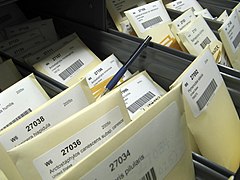
Back بنك البذور Arabic Dipòsit de llavors Catalan Semenná banka Czech Frøbank Danish Saatgutbibliothek German Banco de germoplasma Spanish بانک بذر Persian Siemenpankki Finnish Banque de graines French בנק זרעים HE

A seed bank (also seed banks or seeds bank) stores seeds to preserve genetic diversity; hence it is a type of gene bank.[1] There are many reasons to store seeds. One is to preserve the genes that plant breeders need to increase yield, disease resistance, drought tolerance, nutritional quality, taste, etc. of crops. Another is to forestall loss of genetic diversity in rare or imperiled plant species in an effort to conserve biodiversity ex situ. Many plants that were used centuries ago by humans are used less frequently now; seed banks offer a way to preserve that historical and cultural value. Collections of seeds stored at constant low temperature and low moisture are guarded against loss of genetic resources that are otherwise maintained in situ or in field collections.[citation needed] These alternative "living" collections can be damaged by natural disasters, outbreaks of disease, or war. Seed banks are considered seed libraries, containing valuable information about evolved strategies to combat plant stress, and can be used to create genetically modified versions of existing seeds. The work of seed banks often span decades and even centuries. Most seed banks are publicly funded and seeds are usually available for research that benefits the public.[citation needed]
- ^ Breman, Elinor; Ballesteros, Daniel; Castillo-Lorenzo, Elena; Cockel, Christopher; Dickie, John; Faruk, Aisyah; O’Donnell, Katherine; Offord, Catherine A.; Pironon, Samuel; Sharrock, Suzanne; Ulian, Tiziana (2021-11-03). "Plant Diversity Conservation Challenges and Prospects—The Perspective of Botanic Gardens and the Millennium Seed Bank". Plants. 10 (11): 2371. doi:10.3390/plants10112371. ISSN 2223-7747. PMC 8623176. PMID 34834734.